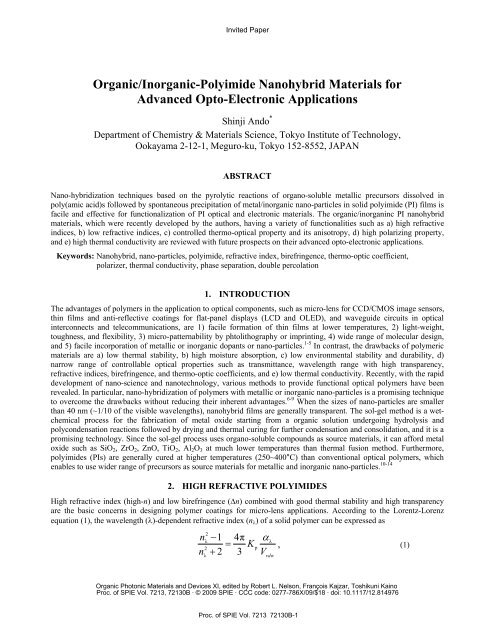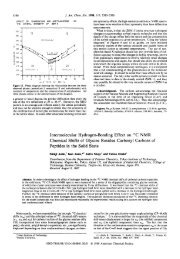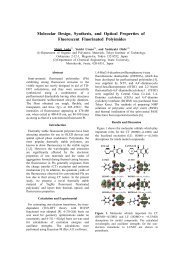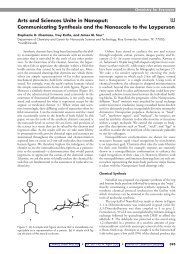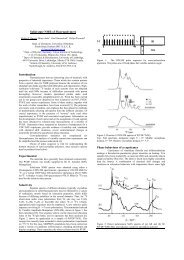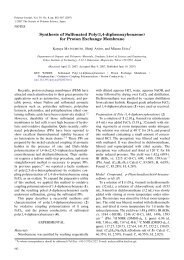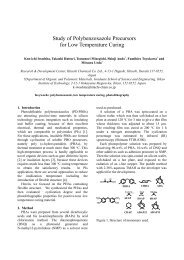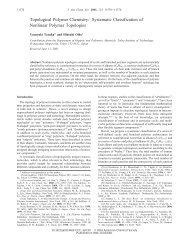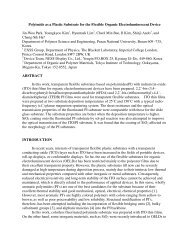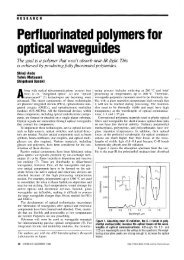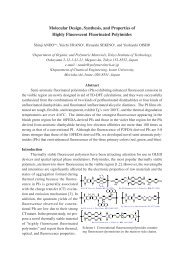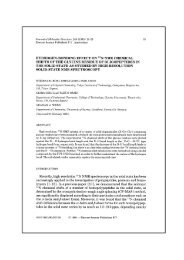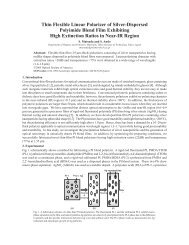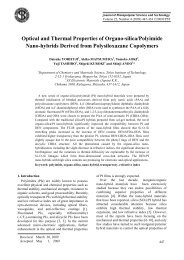Organic/inorganic-polyimide nanohybrid materials for advanced ...
Organic/inorganic-polyimide nanohybrid materials for advanced ...
Organic/inorganic-polyimide nanohybrid materials for advanced ...
You also want an ePaper? Increase the reach of your titles
YUMPU automatically turns print PDFs into web optimized ePapers that Google loves.
Invited Paper<strong>Organic</strong>/Inorganic-Polyimide Nanohybrid Materials <strong>for</strong>Advanced Opto-Electronic ApplicationsShinji Ando *Department of Chemistry & Materials Science, Tokyo Institute of Technology,Ookayama 2-12-1, Meguro-ku, Tokyo 152-8552, JAPANABSTRACTNano-hybridization techniques based on the pyrolytic reactions of organo-soluble metallic precursors dissolved inpoly(amic acid)s followed by spontaneous precipitation of metal/<strong>inorganic</strong> nano-particles in solid <strong>polyimide</strong> (PI) films isfacile and effective <strong>for</strong> functionalization of PI optical and electronic <strong>materials</strong>. The organic/inorganinc PI <strong>nanohybrid</strong><strong>materials</strong>, which were recently developed by the authors, having a variety of functionalities such as a) high refractiveindices, b) low refractive indices, c) controlled thermo-optical property and its anisotropy, d) high polarizing property,and e) high thermal conductivity are reviewed with future prospects on their <strong>advanced</strong> opto-electronic applications.Keywords: Nanohybrid, nano-particles, <strong>polyimide</strong>, refractive index, birefringence, thermo-optic coefficient,polarizer, thermal conductivity, phase separation, double percolation1. INTRODUCTIONThe advantages of polymers in the application to optical components, such as micro-lens <strong>for</strong> CCD/CMOS image sensors,thin films and anti-reflective coatings <strong>for</strong> flat-panel displays (LCD and OLED), and waveguide circuits in opticalinterconnects and telecommunications, are 1) facile <strong>for</strong>mation of thin films at lower temperatures, 2) light-weight,toughness, and flexibility, 3) micro-patternability by phtolithography or imprinting, 4) wide range of molecular design,and 5) facile incorporation of metallic or <strong>inorganic</strong> dopants or nano-particles. 1-5 In contrast, the drawbacks of polymeric<strong>materials</strong> are a) low thermal stability, b) high moisture absorption, c) low environmental stability and durability, d)narrow range of controllable optical properties such as transmittance, wavelength range with high transparency,refractive indices, birefringence, and thermo-optic coefficients, and e) low thermal conductivity. Recently, with the rapiddevelopment of nano-science and nanotechnology, various methods to provide functional optical polymers have beenrevealed. In particular, nano-hybridization of polymers with metallic or <strong>inorganic</strong> nano-particles is a promising techniqueto overcome the drawbacks without reducing their inherent advantages. 6-9 When the sizes of nano-particles are smallerthan 40 nm (~1/10 of the visible wavelengths), <strong>nanohybrid</strong> films are generally transparent. The sol-gel method is a wetchemicalprocess <strong>for</strong> the fabrication of metal oxide starting from a organic solution undergoing hydrolysis andpolycondensation reactions followed by drying and thermal curing <strong>for</strong> further condensation and consolidation, and it is apromising technology. Since the sol-gel process uses organo-soluble compounds as source <strong>materials</strong>, it can af<strong>for</strong>d metaloxide such as SiO 2 , ZrO 2 , ZnO, TiO 2 , Al 2 O 3 at much lower temperatures than thermal fusion method. Furthermore,<strong>polyimide</strong>s (PIs) are generally cured at higher temperatures (250~400°C) than conventional optical polymers, whichenables to use wider range of precursors as source <strong>materials</strong> <strong>for</strong> metallic and <strong>inorganic</strong> nano-particles. 10-142. HIGH REFRACTIVE POLYIMIDESHigh refractive index (high-n) and low birefringence (Δn) combined with good thermal stability and high transparencyare the basic concerns in designing polymer coatings <strong>for</strong> micro-lens applications. According to the Lorentz-Lorenzequation (1), the wavelength (λ)-dependent refractive index (n λ ) of a solid polymer can be expressed asnn2λ2λ−1 4π α= K+ 2 3λpV vdw, (1)<strong>Organic</strong> Photonic Materials and Devices XI, edited by Robert L. Nelson, François Kajzar, Toshikuni KainoProc. of SPIE Vol. 7213, 72130B · © 2009 SPIE · CCC code: 0277-786X/09/$18 · doi: 10.1117/12.814976Proc. of SPIE Vol. 7213 72130B-1
where K p is the molecular packing coefficient, α λ the wavelength-dependent molecular polarizability of a repeating unit,and V vdw the van der Waals volume of a repeating unit. The wavelength dispersion of refractive indices in the visibleregion is usually estimated by Abbe number (ν) which is defined as equation (2).(2)Transparent and colorless <strong>polyimide</strong>s 15 with high refractive indices and high Abbe numbers are preferable <strong>for</strong> thermallystable lens applications. We have demonstrated that the density functional theory (DFT) calculations using the B3LYPhybrid functional can reproduce the wavelength-dependent refractive indices of eight-six organic compounds with highaccuracy. 16-19 As shown in Fig. 1, the experimental Abbe numbers (ν exp ) are well reproduced by the calculated values(ν cal ) with the square correlation factor (r 2 ) of 0.978 as accompanied by the good correlation between the experimental(n exp ) and calculated refractive indices (n cal ). 19 These relations clearly indicate that the DFT is a useful tool to predict theoptical properties of novel polymers suitable to specific applications.70Calculated Ref. Index at 589 nm1.71.61.51.41.31.3 1.4 1.5 1.6 1.7Experimental Ref. Index at 589 nm1010 20 30 40 50 60 70Fig. 1 Relationships between the experimental and calculated (a) refractive indices and (b) Abbe numbers <strong>for</strong> eighty-sixorganic compounds. The refractive indices are the values at 589 nm.Conventional polymers could be endowed with high refractive indices by introducing substituents having higher molarrefraction and lower free molecular volumes. In particular, sulfur-containing substituents are one of the most promisingcandidates. Terui et al. have reported that a PI derived from 3,3’,4,4’-biphenyltetracarboxylic dianhydride (sBPDA) andbis(4-aminophenyl)disulfide exhibit a very high n of 1.698 with a low birefringence of 0.09. 20 Scheme 1 shows thesulfur-containing PIs designed and synthesized by Liu, Ando, Ueda et al. 21-31 The optical absorption spectra and therefractive index dispersions of the PIs derived from APTT diamine and s-BPDA dianhydride are shown in Figs. 2 and 3.The PI (3SDEA-APTT) with the highest sulfur content of 23.2 % shows the highest n of 1.761 at 632.8 nm. This is oneof the highest values in high-n polymers.R=s-BPDAS,SO 2NOOa-BPDAmDPSDASR,OONOR'ODPASnScheme 1 Sulfur-containing fully- and semi-aromatic <strong>polyimide</strong>s (PIs) exhibiting high refractive indices.Calculated Abbe Number, ,CHDA CBDAS3SDEAS6050403020R'=SSDASSExperimental Abbe NumberS3SDASS, SAPTTSSS2SPDA,,,SSSSSAPSTAPDBTSO 2BADPSSSSProc. of SPIE Vol. 7213 72130B-2
Calculated Absorption (arb.unit)Calculated Absorption (arb.unit)210a)3SDEA-APTT (ncal=1.7860)sBPDA-APTT (ncal=1.7703)mDPSDA-APTT (ncal=1.7537)aBPDA-APTT (ncal=1.7487)ODPA-APTT (ncal=1.7622)CBDA-APTT (ncal=1.7096)CHDA-APTT (ncal=1.6871)1.650300 350 400 450 500400 600 800 1000 1200 1400Wavelength (nm)Wavelength (nm)Fig. 2 a) Calculated absorption spectra with calculated refractive indices (inset), and b) experimental absorption spectraand wavelengths dispersion of refractive indices of the PI films derived from APTT diamine.1.650300 350 400 450 500400 600 800 1000 1200 1400Wavelength (nm)Wavelength (nm)Fig. 3 a) Calculated absorption spectra with calculated refractive indices (inset), and b) experimental absorption spectraand wavelengths dispersion of refractive indices of the PI films derived from sBPDA dianhydride.As shown Figs 2 and 3, the experimental absorption edges agree well with the calculated values obtained by TD-DFTmethod, and the refractive index dispersions are well fitted by the simplified Cauchy's <strong>for</strong>mula (n λ =n ∞ +D/λ 2 ). 33 The n ∞reflects the inherent refractive index of a PI, which is not influenced by the electronic absorptions in the UV region.Figure 4 shows the relationships between the values of n ∞ and D, which were obtained from thirty kinds of PIs. Twodifferent linear relationships are observed <strong>for</strong> the semi-alicyclic and aromatic PIs, respectively, which agree well with therelation that we have reported previously. 33 The higher n, the larger D, which straight<strong>for</strong>wardly indicates that a high-nrarely exists with a low D. Among the various dianhydrides, ODPA and mDPSDA dianhyrides having lower electronaffinities, can provide PIs with higher transparency and lower dispersion.Dispersion Coef, D (10 4 nm 2 )2102.42.22.01.81.61.41.23SDEAsBPDAaBPDAODPADPSDACBDACHDAa)sBPDA-APTT (ncal=1.7703)sBPDA-APDBT (ncal=1.7705)sBPDA-APST (ncal=1.7317)sBPDA-3SDA (ncal=1.7327)sBPDA-SDA (ncal=1.7089)sBPDA-2SDPA (ncal=1.7260)sBPDA-BADPS (ncal=1.7086)1.60 1.65 1.70Refractive Index at the infinite wavelength, n ∞Refractive IndexRefractive Index1.801.751.701.801.751.70b)Wavelength dispersionAbsorption spectrumb)Wavelength dispersionAbsorption spectrumsBPDA-APTTaBPDA-APTTODPA-APTT3SDEA-APTTCHDA-APTTCBDA-APTTmDPSDA-APTTsBPDA-APTTsBPDA-APDBTsBPDA-3SDAsBPDA-2SPDAsBPDA-SDAsBPDA-BADPSsBPDA-APST1.510.51.510.5AbsorbanceAbsorbanceFig. 4 Relations between the n ∞ values and the dispersioncoefficients (D) <strong>for</strong> the PIs derived from various dianhydrides.Fig.5 SEM pictures of PI(CHDA-APTT)−TiO2 (55:45 w/w)nanochybrid film and 4 μm-pitch negative patterns (1 μm-thick).Proc. of SPIE Vol. 7213 72130B-3
5. POLYIMIDE THIN FILM POLARIZERLinear polarizing films made of poly(vinyl alcohol) films dyed with iodine (I 2 ) are widely used <strong>for</strong> liquid crystallinedisplays (LCDs), but this type of films cannot be used <strong>for</strong> optical communication applications because iodine does notexhibit anisotropic absorptions in the near-infrared (NIR) region. Instead, <strong>inorganic</strong> polarizer fabricated by uniaxialelongation of silver or copper nano-particles dispersed in <strong>inorganic</strong> glasses are used in fiber-optic devises such as opticalisolators. Metal nano-rods show significant polarizing properties in the visible-NIR regions, though glass matrix havedrawbacks in the thickness (150~200 μm), fragility, processability, and mass-production. Hence, we tried to fabricatethin film polarizers based on silver nano-particles dispersed in colorless and transparent PIs having rigid-rodstructures. 42-45 As shown in Fig. 10, a new series of copolymers consisting of a sulfur-containing PAA having highaffinity to noble metals and a fluorinated PAA having low affinity were prepared, and silver nitrate was dissolved in aDMAc solution of the PAA. Due to the large difference in hydrophobicity between the two components, the dried PAAfilms exhibited typical micro-phase separation, and energy dispersive spectroscopy (EDS) clarified that nanometer-sizedsilver particles were selectively concentrated and precipitated in the sulfur-rich domain. During simultaneous curing anduniaxial drawing at higher temperatures (>350°C), the PI films showed apparent polarizing properties in the visible-NIRregions due to the de<strong>for</strong>med shapes of silver nano-particles. Since it has been reported that the melting temperatures (T m )of metal nano-particles are significantly lower than those of bulk (T m of bulk silver is 689°C), such nano-particles can beelongated at appropriate conditions (temperature, atmosphere, and tensile stress). We developed a new apparatus <strong>for</strong> thein-situ and real-time observation of polarized transmission spectra to monitor and control the temperature and drawingconditions. The silver nano-rods thus precipitated in the PI blend film show significantly elongated shapes (50−300 nm)with perfect orientation along the drawing direction (Fig. 10). The WAXD pattern of the film shows that these particlesare nano-crystallites of zero-valent silver, and the PI film thus obtained shows very good polarizing property (dichroicratio: >300 at 1550 nm) with high optical transmission (>70 %) as shown in Fig. 11. In addition, the PI film is only 15μm-thick (ca. ~1/10 of <strong>inorganic</strong> polarizers), tough, and flexible, which leads to great advantages in processability andmass-production required <strong>for</strong> the applications in micro-optics and waveguide devises such as optical isolator.PI-1PI-2(High Affinity to Silver)Ag +Ag nanorodTEMMagnifiedPoly(amic acid)AgNO 3Uniaxialdrawing&HeatingHeatingSilverO O CF 3NONO CF 3PMDA/TFDB (PI-1)nhtONONSO 3 HO O SO 3 HPMDA/BDSA (PI-2)htnPolyimide20Fig. 10 Schematic representation of spontaneous condensation and precipitation of silver nano-particles having elongatedshapes in the sulfur-containing phase in PI blend films (left) and TEM micrographs of the PI film with silver (right).100Transmittance (%)80604020OpticalcommunicationwavelengthT ⊥T ||Thin FilmWaveplate00.5 1.0 1.5 2.0 2.5Wavelength (0m)Thin Film PolarizerGLICABASE U rca ow$ILQONf$T)Fig. 11 Polarized optical transmission spectra of a PI film containing silver nanoparticles having elongated shapes, andan example of applications of PI thin film polarizer and half-waveplates <strong>for</strong> a waveguide-type optical isolator.Proc. of SPIE Vol. 7213 72130B-6
6. POLYIMIDE THIN FILMS WITH HIGH THEMAL CONDUCTIVITYThermally stable polymers with high thermal conductivity are strongly needed <strong>for</strong> efficient heat transfer in electronicapplications. Polymers hybridized with metal oxide particles have been widely studied, but their improvement in thermalconductivity is limited due to the large interfacial thermal resistance between polymer and fillers. We have proposed anew strategic design <strong>for</strong> effective increase in thermal conductivity based on the selective precipitation of silver nanoparticlesin micro phase-separated PI blends as illustrated in Fig. 12. 46 PI blend films (sBPDA/SDA-TFDB) consisting oftwo-types of PIs having different affinities to silver ions were prepared. Silver nitrate (AgNO 3 ) dissolved in PAAsolutions was thermally reduced to metallic silver during imidization, which <strong>for</strong>ms silver nano-particles in the films. Fig.12 shows the FE-SEM micrographs of the hybrid films, in which ‘double percolation’ structures orienting along the outof-planedirection were clearly <strong>for</strong>med, and the average size of each phase is in ~10 μm order. Energy-dispersive X-rayspectroscopy (EDS) also showed that silver nano-particles were preferentially precipitated in the S-PI phase due to thehigh affinity with noble metals. The thermal diffusivity along the out-of-plane direction (a ⊥ ) were measured with an ACtemperature-wave analyzer (thermal conductivity is the product of a and a specific heat). At 20 mol% of AgNO 3 , the PIblend films of SDA:TFDB=50:50 (mol%) exhibit a higher thermal diffusivity than the pristine PI having homogeneouslydispersed silver nanoparticles and the other PI blends having typical sea-island structures. This clearly implies that thedouble percolation structures thus generated function as thermal conductivity pathways along the out-of-plane direction.Small sea-island30μmLarge sea-island30μmDouble percolationS-PI(30)/F-PI(70)/AgNO 3 (20) S-PI(40)/F-PI(60)/AgNO 3 (20) S-PI(50)/F-PI(50)/AgNO 3 (20)30μmα = 17.6α = 17.9α = 20.9(x10 -8 m 2 /s)S-PINOOOONAgAgSAgAgxNOOOONCF 3F 3 C100-xF-PIFig. 12 Cross-sectional FE-SEM photographs of the micro phase-separated PI hybrid films consisting of sulfurcontainingPI (S-PI) and fluorine-containing PI (F-PI). The phase separation and silver precipitation areschematically illustrated below the photos. The S-PI phase containing silver nano-particles are seen as white parts.7. SUMMARY<strong>Organic</strong>/inorganinc PI <strong>nanohybrid</strong> <strong>materials</strong> having optical functionalities, such a) high refractive indices (n=1.81), b)low refractive indices (n=1.47), c) controlled thermo-optical property (|dn/dT| >350 ppm/K) and its anisotropy, d) highpolarizing property (dichroic ratio > 25 dB), and e) good thermal conductivity have been developed by the <strong>nanohybrid</strong>izationtechniques based on the pyrolytic reactions (reduction, oxidation, and decomposition) of organo-solublemetallic precursors followed by spontaneous precipitation of metal/<strong>inorganic</strong> nano-particles in solid PI films. Thistechnique enables us to develop novel opt0-electronic <strong>materials</strong> having a variety of functionality with maintaining theinherent excellent properties of PIs.Acknowledgement : The author acknowledges that the results reviewed in this paper have been obtained by fruitfulcollaborations with Prof. Mitsuru Ueda, Yuji Shibasaki, Sho-ichi Matsuda, Yoshiharu Terui, Akiko Matsumura, YasuoSuzuki, Nam Ho You, Atsuhisa Suzuki, Yasuhiro Nakamura (Tokyo Tech), Jin-gang Liu (present: the Chinese academyof science), and Claudio A. Terraza (present: Pontificia univ. Catolica de Chile).Proc. of SPIE Vol. 7213 72130B-7
[1][2][3][4][5][6][7][8][9][10][11][12][13][14][15][16][17][18][19][20][21][22][23][24][25][26][27][28][29][30][31][32][33][34][35][36][37][38][39][40][41][42][43][44][45][46]REFERENCESSullivan, C. T., Proc. SPIE, 994, 92 (1988).Reuter, R., Franke, H. and Feger, C., Applied Optics, 27, 4565 (1988).Franke, H., Wagner, D., Kleckers, T., Reuter, R., Rohitkumar, H.V. and Blech, B.A., Applied Optics, 32, 2927(1993).Hougham, G., Cassidy, P.E., Johns, K. and Davidson, T., eds. “Fluoropolymers 1: Synthesis and 2: Properties”,Kluwer Academic/ Plenum Publishers, New York (1999).Ando, S., J. Photopolym. Sci. Technol., 17, 219 (2004).Weibel, M., Caseri, W., Suter, U.W., Kiess, H. and Wehrli, E., Adv. Mater., 2, 75 (1991).Zimmermann, L., Weibel, M., Caseri, W.U., Suter, W. and Walther, P., Polym. Adv. Technol., 4, 1 (1993).Althues, H., Henle, J. and Kaskel, S., Chem. Soc. Rev., 36, 1454 (2007).Kickelbick, G., 'Hybrid Materials, Synthesis, Characterization, and Applications', Wiley-VCH (2007).St. Clair, A.K. and Taylor, L.T., J. Appl. Polym. Sci., 28, 2393 (1983).Rancourt, J.D., Porta, G.M. and Taylor, L.T., Chem. Mater.,1, 269 (1989).Ellison, M.W. and Taylor, L.T., Chem. Mater., 6, 990 (1994).Rubira, A.F., Rancourt, J.D., Caplan, M.L., St.Clair, A.K. and Taylor, L.T., Chem. Mater., 6, 2351 (1994).Sawada T. and Ando, S., Chem. Mater., 10, 3368 (1998).Ando, S., Matuura, T. and Sasaki, S., Polymer J., 29, 69 (1997).Ando, S., Fujigaya, T. and Ueda, M., Jpn. J. Appl. Phys., 41, L105 (2002).Ando, S., Fujigaya, T. and Ueda, M., J. Photopolym. Sci. Technol., 15, 559 (2002).Ando, S. and Ueda, M., J. Photopolym. Sci. Technol., 16, 537 (2003).Ando, S. J. Photopolym. Sci. Technol., 19, 351 (2006).Terui, Y. and Ando, S., J. Photopolym. Sci. Technol., 18, 337 (2005).Liu, J.-G., Nakamura, Y., Shibasaki, Y., Ando, S. and Ueda, M., Polym. J., 39, 543 (2007).Liu, J.-G., Nakamura, Y., Shibasaki, Y., Ando, S., Ueda, M., Macromolecules, 40, 4614 (2007).Liu, J.-G., Nakamura, Suzuki, Y., Y., Shibasaki, Y., Ando, S. and Ueda, M., Macromolecules, 40, 7902 (2007).Liu, J.-G., Nakamura, Y., Suzuki, Y., Shibasaki, Y., Ando, S. and Ueda, M., J. Polym. Sci. Part A, Polym Chem.,45, 5606 (2007).Liu, J.-G., Nakamura, Y., Ogura, T., Shibasaki, Y., Ando, S. and Ueda, M., Chem. Mater., 20, 273 (2008).Liu, J.-G., Shibasaki, Y., Ando, S. and Ueda, M., High Per<strong>for</strong>m. Polym., 20, 221 (2008).Liu, J.-G., Nakamura, Y., Terraza, C.A., Shibasaki, Y., Ando, S. and Ueda, M., Macromol. Chem. Phys., 209, 195(2008).C.A. Terraza, Liu, J.-G., Nakamura, Y., Shibasaki, Y., Ando, S. and Ueda, M., J. Polym. Sci., Part A: Polym.Chem., 46, 1510 (2008).Suzuki, Y., Liu, J.-G., Nakamura, Y., Shibasaki, Y., Ando, S. and Ueda, M., Polymer J., 40, 414You, N.-H., Suzuki, Y., Yorifuji, D., Ando, S. and Ueda, M., Macromolecules, 41, 6361 (2008).You, N.-H., Suzuki, Y., Higashihara, T., Ando, S. and Ueda, M., Polymer (2009) (in press).Suzuki, Y., Nakamura, Y., Ando, S. and Ueda, M., J. Photopoly. Sci. Technol., 21, 131 (2008).Ando, S., Watanabe, Y. and Matsuura, T., Jpn. J. Appl. Phys. Part 1, 41, 5254 (2002).Ando, S., Suzuki, A., Nakamura, Y., Liu, J.-G. and Ueda, M., Proc. STEPI, 8, (2008) (in press).Matsuda, S., Urano, Y., Park, J.-W., Ha, C.-S. and Ando, S., J. Photopolym. Sci. Technol., 17, 241 (2004).Fujihara, S., Tada, M. and Kimura, T., Thin Solid Films, 304, 252 (1997), ibid, 389, 227 (2001).Terui, Y. and Ando, S., Appl. Phys. Lett., 83, 4755 (2003).Terui, Y. and Ando, S., J. Photopolym. Sci. Technol., 18, 337 (2005).Terui, Y. and Ando, S., Proc. SPIE, 5724, 336 (2005).Terui, Y. and Ando, S., High Per<strong>for</strong>m. Polym., 18, 825 (2006).Matsumura, A., Terui, Y., Ando, S., Abe, A. and Takeichi, T., J. Photopolym. Sci. Technol., 20, 167 (2007).Sawada, T., Ando, S. and Sasaki, S., Appl. Phys. Lett., 74, 938 (1999).Matsuda, S., Ando, S. and Sawada, T., Electron. Lett., 37, 706 (2001).Matsuda, S. and Ando, S., Polym. Adv. Technol., 14, 458 (2003).Matsuda, S., Yasuda, Y. and Ando, S., Adv. Mater., 17, 2221 (2005).Yorifuji, D. and Ando, S., (submitted <strong>for</strong> publication).Proc. of SPIE Vol. 7213 72130B-8


